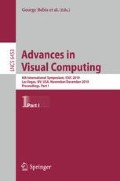Abstract
We propose a depth assisted video object tracking algorithm that utilizes a stereo vision technique to detect and handle various types of occlusions. The foreground objects are detected by using a depth and motion-based segmentation method. The occlusion detection is achieved by combining the depth segmentation results with the previous occlusion status of each track. According to the occlusion analysis results, different object correspondence algorithms are employed to track objects under various occlusions. The silhouette-based local best matching method deals with severe and complete occlusions without assumptions of constant movement and limited maximum duration. Experimental results demonstrate that the proposed system can accurately track multiple objects in complex scenes and provides improvements on dealing with different partial and severe occlusion situations.
Access this chapter
Tax calculation will be finalised at checkout
Purchases are for personal use only
Preview
Unable to display preview. Download preview PDF.
References
Pan, J., Hu, B., Zhang, J.: Robust and accurate object tracking under various types of occlusions. IEEE Transactions on Circuits and Systems for Video Technology 18(2) (2008)
Zhu, J., Lao, Y., Zheng, Y.: Effective and robust object tracking in constrained environments. In: Proceedings of IEEE International Conference on Acoustics, Speech and Signal Processing, pp. 949–952 (2008)
Guo, Y., Hsu, S., Sawhney, H.S., Kumar, R., Shan, Y.: Robust object matching for persis-tent tracking with heterogeneous features. IEEE Transactions on Pattern Analysis and Machine Intelligence 29(5), 824–839 (2007)
Yilmaz, A., Li, X., Shah, M.: Contour-based object tracking with occlusion handling in video acquired using mobile cameras. IEEE Transactions on Pattern Analysis and Machine Intelligence 26(11), 1531–1536 (2004)
Jepson, A., Fleet, D., El-Maraghi, T.: Robust online appearance models for visual tracking. IEEE Transactions on Pattern Analysis and Machine Intelligence 25(10), 1296–1311 (2003)
Parvizi, E., Wu, Q.: Multiple object tracking base on adaptive depth segmentation. In: IEEE Conference on Computer and Robot Vision, pp. 273–277 (2008)
Krotosky, S.J., Trivedi, M.M.: On Color-, Infrared-, and Multimodal-Stereo Approaches to Pedestrian Detection. IEEE Transactions on Intelligent Transportation Systems 8(4) (2007)
Harville, M.: Stereo person tracking with short and long term plan-view appearance models of shape and color. In: IEEE International Conference on Advanced Video and Signal based Surveillance, pp. 522–527 (2005)
Beymer, D., Konolige, K.: Real-time tracking of multiple people using stereo. In: IEEE Frame Rate workshop (1999)
Tang, F., Harville, M.: Fusion of local appearance with stereo depth for object track-ing. In: IEEE Computer Vision and Pattern Recognition Workshops, pp. 1–8 (2008)
Okada, R., Shirai, Y., Miura, J.: Object tracking based on optical flow and depth. In: IEEE International Conference on Multisensory Fusion and Integration for Intelligent Systems, pp. 565–571 (1996)
Huang, Y., Fu, S., Thompson, C.: Stereovision-based object segmentation for automotive applications. EURASIP Journal on Applied Signal Processing, 2322–2329 (2005)
Senior, A.: Tracking people with probabilistic appearance models. In: ECCV Workshop on Performance Evaluation of Tracing and Surveillance Systems, pp.48–55 (2002)
Cavallaro, A., Steiger, O., Ebrahimi, T.: Tracking video objects in cluttered background. IEEE Transactions on Circuits and Systems for Video Technology 15(4), 575–584 (2005)
Zhu, L., Zhou, J., Song, J.: Tracking multiple objects through occlusion with online sampling and position estimation. Pattern Recognition 41(8), 2447–2460 (2008)
Nguyen, H.T., Smeulders, A.W.M.: Fast occluded object tracking by a robust appearance filter. IEEE Transactions on Pattern Analysis and Machine Intelligence 26(8), 1099–1104 (2004)
Porikli, F., Tuzel, O.: Human body tracking by adaptive background models and mean-shift analysis. In: IEEE International Workshop on Performance Evaluation of Tracking and Surveillance (2003)
Author information
Authors and Affiliations
Editor information
Editors and Affiliations
Rights and permissions
Copyright information
© 2010 Springer-Verlag Berlin Heidelberg
About this paper
Cite this paper
Ma, Y., Chen, Q. (2010). Depth Assisted Occlusion Handling in Video Object Tracking. In: Bebis, G., et al. Advances in Visual Computing. ISVC 2010. Lecture Notes in Computer Science, vol 6453. Springer, Berlin, Heidelberg. https://doi.org/10.1007/978-3-642-17289-2_43
Download citation
DOI: https://doi.org/10.1007/978-3-642-17289-2_43
Publisher Name: Springer, Berlin, Heidelberg
Print ISBN: 978-3-642-17288-5
Online ISBN: 978-3-642-17289-2
eBook Packages: Computer ScienceComputer Science (R0)

